


Double-edged
sword:
The Reliant Scimitar SS1
by Dan
Lockton
All the elements pointed to a triumphant return of the British sports car for the 1980s: Michelotti styling, a superb chassis, a rust-free body, a range of performance options, and modern creature comforts. But putting it all together, the SS1 sadly failed to cut it with buyers.

By the late Seventies, the affordable, mass-market convertible sports car appeared to be on its way out. BL had abandoned further development at MG, with Abingdon closing in 1980, and even the TR7, on which its future sports car plans had initially centred, was not to survive 1981.
Earlier rumours — ultimately incorrect — that forthcoming safety legislation in the US would outlaw soft-tops, had led to major manufacturers dropping convertibles, or replacing them with targa-topped arrangements as on the Fiat X1/9 and Datsun 280ZX, offering roll-over protection and better body rigidity. While smaller manufacturers not dependent on US sales were able to continue with traditional convertibles, these were hardly mass-market cars.
As Daniel Ward of Motor put it, "A whole section of car buyers has disappeared... the driver of a modestly priced open sports car is an almost extinct breed with no more than the rotting remains of MGBs and Triumph Spitfires sighted as a reminder of a bygone era in motoring".
Reliant investigates the possibilities
Reliant, based in Tamworth, Staffordshire, had long focused on exploiting sections of the market ignored by larger manufacturers. Although a number of plans—including a one-box people carrier—were abandoned after a 1977 reorganisation (in which the majority owner, Standard Chartered Bank, sold its shares to JF Nash Securities of Kettering, followed by significant personnel changes at the top of the company), the idea of a smaller sports car to complement the Scimitar GTE was retained and taken up enthusiastically by the new management. With the changes at BL, such a car would probably have few competitors by the time it reached production.
Reliant's new 30 year-old chief engineer, Ed Osmond — replacing Derek P Peck, who returned to BL — had served a graduate apprenticeship at Leyland, and was latterly a principal engineering development coordinator on the TR7 under Spen King. Once appointed to the role at Reliant, he began investigating the opportunities for producing a new sports car, between the Spitfire and the MGB in size and intended market position.
Given Reliant's expertise and facilities, the new sports car — codenamed SS1, 'Small Sports 1' — may have been expected to use a stressed GRP body on a separate steel chassis, as on the Scimitar GTE and the economy cars (at this time, Robin and Kitten). Nevertheless, Osmond and his team considered basing the SS1 on a mass-produced saloon platform, ideally gaining access to a major dealer network in the process (in the same way that Bond had produced the Herald/Vitesse-based Equipe for sale through Triumph dealers).
Reliant was, at this time, doing sub-contract work for Vauxhall, customising Chevettes (believed to be the HS), and coincidentally or otherwise, the parties discussed putting Wayne Cherry's 1978 Vauxhall Equus sports car into production, possibly in conjunction with Panther Westwinds who had built the prototypes. The Equus was a sharply styled convertible two-seater with an evolution of Cherry's characteristic 'droop-snoot' at the front and an angular rear deck; however, nothing came of the discussions and it remained a concept car.
Once a decision was made to design the SS1 independently of association with a single larger manufacturer, Ed Osmond put together a specification for the new car, taking into account Reliant's capabilities and opportunities for future technical development, his experiences with the TR7 at BL, and — as a sports car enthusiast and former TR2 and Spitfire owner himself — what he believed would appeal to the intended market. Interviewed in Car magazine at the SS1's launch, Osmond commented: "[The TR7] was a bit bland, derived too much from a saloon. I think the TR6 was everyone's idea of a sports car. I wanted the Scimitar [the SS1] to have a definite sporty appeal along the line of the TR6. It had to have a fair-sized engine, be inexpensive, reliable and reasonably quiet."
The SS1 was, then, intended to combine the appealing features of the 'traditional' British sports car—fun, relatively cheap, two-seater wind-in-the-hair motoring—with a sensible choice of modern, more reliable mechanical components and increased refinement. Reliant summarised it as combining "the driving pleasure of an open-top sports car with the practical benefits and comfort of a contemporary saloon."
A longer-term aim of the SS1 project was for Reliant to break into the US market, hoping to establish distribution deals similar to those which had allowed MG, Austin-Healey and Triumph to thrive, and much of the design bore potential US requirements in mind.
Michelotti's proposal
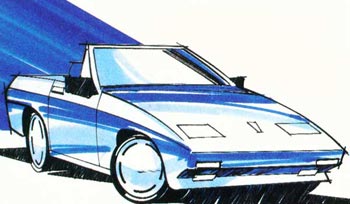
This sketch, as shown in the SS1 publicity material,
is probably something of a post-rationalisation by Reliant of Michelotti's
original proposals.
As part of the plan, Giovanni Michelotti of Turin, who had styled a long line of successful Triumph sports cars, including the Spitfire, TR4/5 and Stag, was signed up to design the SS1 body, and by the end of 1978 the initial proposal was delivered to Reliant. (It's not clear if Reliant's other design consultants at this point, Ogle and Bertone, were also asked for SS1 proposals, though they did both work on proposed larger sports cars for Reliant).
It's been claimed that Michelotti often spent just a few minutes on sketching new car ideas to pitch to clients, presumably preferring to do detailed presentation work only once the job had been accepted; it's also been rumoured that his SS1 proposal was merely a recycling of a rejected Spitfire replacement proposal from a few years previously, but this is not necessarily something to criticise, since Reliant was presumably looking for Michelotti's vision of an update of the British sports car tradition.
Michelotti presented a car similar in profile to the TR7, with a sharp nose and flared 'eyebrows' over the wheel arches. To some extent the rear eyebrows, combined with a waistline stepped up behind the doors, recalled the distinctive 'haunch' of the Spitfire and TR6, but this effect was much reduced by the sharper styling. As a crucial part of the SS1 story, we will return to examine the body styling further in due course, but it's worth noting that at this stage, before the method of body construction had been decided, the Michelotti design was probably 'distinctive' rather than over-fussy, with most of the numerous panel gap variances and detailing issues being determined later by the construction method.
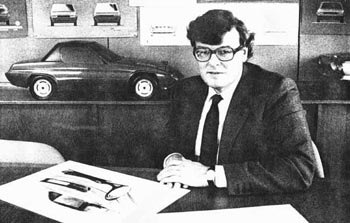
This SS1 styling model, here with Reliant’s
managing director, Ritchie Spencer, shows a cleaner shape less encumbered
by panel gaps; the wheelarch eyebrows are still evident, however.
Traditional layout...
Reliant decided early in the SS1 programme—presumably before approaching Michelotti—that a classic front engined, rear-driven layout was the way to go. In 1969-70 Reliant and Ogle had tested a mid-engined two-seater (the FW7), with an advanced shape anticipating the Fiat X1/9 and Pontiac Fiero, but a decade later it was still felt that the familiarity of a traditional layout would both reassure and appeal to the intended market for the SS1. Since there was more precedent on which to draw, chassis design and handling characteristics could be refined in the light of experience with other manufacturers' designs.
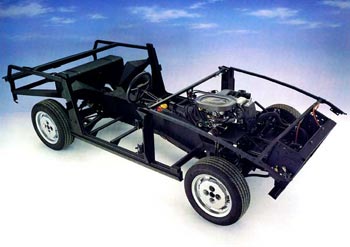
The SS1 chassis, fabricated by Thyssen in West Germany,
combined a stiff Lotus-like central backbone with large subframes to support
the unstressed body panels. Note the angle of the front dampers.
Ed Osmond — appointed to the board as engineering director in July 1980—planned a steel backbone chassis similar in appearance to that of the Lotus Elan and 501 Elite/Eclat — an elongated X-shape in plan, with a deep central tunnel, very stiff in torsion, through which the propshaft was run.
However, unlike the Lotus cars in which the GRP body was stressed along with the chassis, the SS1's body construction was to follow a different route (see below) which meant that the complete chassis—optimised on computer using finite element analysis (FEA), a first for Reliant—ended up much more complex. Presumably for this reason, Reliant contracted the chassis fabrication to Thyssen Industrie AG, of Bielefeld, North Rhine-Westphalia, which retained some intellectual property rights over the design, though Reliant took a 46 per cent stake in the tooling (in 1986 increased to 60 per cent, at which point its total value was put at £1,150,000).
Reliant intended the SS1 to be available in a range of performance options, with a cheaper-to-insure lower-powered version seen as an important way to attract younger buyers: after all, the Spridget had always been more about fun than speed. Higher performance versions of the SS1 were also planned, so the chassis and suspension were designed to cope, although in the event it was to be a couple of years after launch before this potential was exploited.
Although Reliant had built its own small-capacity engines since 1939, including — before the Imp — the UK's first mass-produced aluminium engines from 1962, there were no plans to develop larger capacity units, mainly because of the small scale of Reliant sports car production. Reliant intended to produce 2000 SS1s a year for the UK; at these levels, a reliable set of powertrains from a major manufacturer, with good spares and service backup, was needed.
Reliant considered BL, Vauxhall, Fiat and Toyota powertrains, settling on the new Bridgend-built Ford CVH 1.3- and 1.6-litre units, introduced in 1980 in the Escort and later used on the Fiesta and Orion, matched to four- and five-speed gearboxes and differential from the forthcoming (rear-wheel drive) Sierra. Reliant's managing director, Ritchie Spencer, was keen to use common British-built engines, to make aftermarket tuning and development easier for SS1 buyers: from Reliant's experience with the use of Ford Essex units in the Scimitar GTE, this helped breed brand loyalty and a thriving enthusiasts' scene.
The CVH engines, acquired via Ford's industrial power product sales channel, were mounted well back in the SS1 chassis, both to allow the low nose of Michelotti's design and to achieve a near 50/50 weight distribution; following the practice on the larger Scimitars, the spare wheel was to be stored in front of the engine, behind the radiator, which freed up room for the boot to be as large as possible within the small envelope available, though increasing the front overhang.
Reliant made extensive use of the test track, pavé and other facilities of the Motor Industry Research Association (MIRA) — of which Ritchie Spencer was also chairman — along the A5 at Nuneaton, to hone the SS1's handling. Ed Osmond and his team devised a double wishbone suspension system (with coil springs and an anti-roll bar) for the front of the car, with all loads fed into the central backbone, and dampers inclined at about 60 degrees from the vertical to meet on the chassis in front of the engine, again to allow a low bonnet line. At the back, trailing arms and coil springs with an anti-roll bar completed the all-independent setup which was to be one of the SS1's most highly regarded features once in production.
...but advanced body engineering
The turn of the decade was a dark time for Reliant and sales of the Scimitar GTE and new GTC (a T-bar convertible along the lines of an upmarket Stag) dwindled as the recession bit, although the introduction of the IAD-styled Rialto in early 1981 gave three-wheeler sales a boost. The radical SE82 project, a Bertone-styled GTE replacement with a Rover V8, was cancelled in 1980 after significant expenditure.
JF Nash Securities broke up the Reliant Motor Group in 1981, floating Reliant Motor plc independently on the Unlisted Securities Market while retaining other companies such as Press Operations, formerly Reliant's chassis supplier. The Nash family itself, however, remained in overall control of Reliant Motor plc. In its first year of independence, Reliant lost over £1,000,000, and reduced its workforce further — down to 450 by the end of 1981, at which time Tamworth had 20 per cent unemployment. A rumoured deal with Hyundai, under which Reliant would become its UK importer, making use of its existing dealer network, would have provided useful cash flow, but did not materialise.
Nevertheless, Reliant's R&D and engineering functions were maintained, and within a few months of independence, a new subsidiary, Reliant Industrial Mouldings Ltd, was formed to exploit the company's expertise in plastics: one of the first products shown, the 'Guttagard', was a new system for repairing deteriorating concrete guttering using GRP liners.
Reliant had already gone beyond traditional hand-lay GRP methods in the early Seventies, with the introduction of heated presses for rapid production of Robin and Kitten doors and bonnets, and the SS1 was intended to continue reduction of labour-intensive aspects of body production. Plastics beyond GRP would be explored, both for the SS1 and to widen Reliant Industrial Mouldings' abilities.
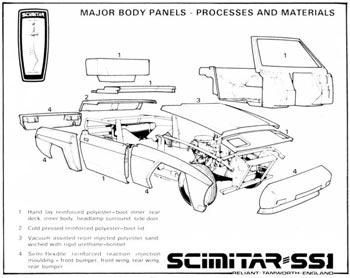
The four different plastics used in the SS1’s
body construction. (Click image to enlarge)
A body structure for the SS1 was devised with many similarities to the Pontiac Fiero concurrently being developed by GM: unstressed plastic panels, with properties appropriate to their location on the car, supported by an underbody frame (and fixed to it using Torx bolts). Plastics giant Bayer had experimented with a similar method in the late 1960s but no manufacturer at the time had taken it up. Whilst the Fiero made use of significant levels of automation (with a $300m development budget), this was beyond Reliant's capabilities.
To satisfy US parking impact requirements, something more advanced than GRP was needed for the front and rear bumper sections, and investigation of the 'friendly fenders' used on the Porsche 928, and indeed the Fiero, led to the choice of reinforced reaction injection-moulded (RRIM) polyurethane for these, produced in conjunction with Dunlop. The bumper sections would, in theory, spring back to their original shape without yielding in minor impacts, with no need for separate (and ugly) rubber bumpers as used on the TR7 and late-model MGB and Midget.
Also used for the SS1's front and rear wings—hence the 'controversial' stiffening rib features of the sculpted recess and wheelarch mouldings—this material was elastic enough for journalists to be allowed to bend and jump on wing sections provided for this purpose. The resilience and ease of replacement of these panels also tallied with the intention for the lower-powered SS1s to be cheap to insure for younger drivers.
RRIM polyurethane was not stiff enough for unsupported horizontal panels such as the boot lid and bonnet; the boot lid was thus produced from pressed GRP, but for the bonnet — a rather larger panel than that on the GTE or Rialto — a more complex process, vacuum-assisted resin injection (VARI) was employed. This process, patented by Lotus in 1976 and first used on the Excel (and currently on the Elise), involves a rigid 'sandwich' — in Reliant's case, polyurethane foam between two layers of fibreglass mat — being placed between precision-fitting moulds (with the gelcoat on the female mould, and the steel bonnet hinge brackets also inserted at this point); a vacuum is applied between the sealed moulds and a measured quantity of polyester resin is injected. The cured part can then be trimmed and painted.
VARI in theory allows precise dimensional and weight control, but in Reliant's case, it seems as though the lack of experience with the process may have contributed to expensive production problems which plagued the SS1 throughout its life. A 1988 (internal) audit summary memorandum by Deloitte Haskins Sells notes that Reliant was producing, "on average 2½ bonnets per car due to [the] problem of getting them the right size".
The doors, headlamp surround, rear deck and one-piece cabin/floorpan/bulkhead/windscreen surround were all produced using hand-laid GRP, as the most cost-effective method of achieving the required properties.
As mentioned earlier, the fabrication of the complex chassis and underbody frame required to support the body panels was contracted out to Thyssen, with the panels being attached and the cabin/floorpan moulding inserted in place once the assembly arrived at Reliant. Unlike the Pontiac Fiero, which benefited from a laser-guided 'mill and drill' system for aligning the body panels on the frame (with a claimed accuracy of 0.5 mm), the SS1 relied on manual assembly of the panels, with less consistency in achieving even panel gaps. On some parts of the car, such as the boot lid/rear wing interface, the panels simply seem to have slightly different curvatures, leading to the gap at one end being greater than the other; it's also possible that the correct shrinkage tolerance for the type of plastic was not designed into the moulds for some panels, again leading to visibly mismatched continuity of curvature and feature lines. To Reliant's credit, the shut-lines for the SS1's doors generally seemed to be pretty tight and consistent.
Giovanni Michelotti died of cancer in 1980, before much of the SS1's design was finalised, and indeed before the decisions on body construction had been made. Whilst his son, Edgardo, took over the management of the studio, the SS1 contract was continued by Tateo Uchida, the chief stylist. Reliant's managing director, Ritchie Spencer, admitted to Autocar in 1986 that the elder Michelotti's death had a large impact on the way the SS1 looked: "Had Michelotti not died, I think it would have ended up with a much cleaner shape. He left the original shape with few of the production details. When we decided to go for the panel construction we then added a whole new series of lines on the car that had never been envisaged at the design stage. We had to — it's the way the car's constructed. Those extra lines interfered with the simplicity of the original shape, and we didn't have Michelotti around to yell 'Stop, you can't do that...'"
Another issue with the SS1's appearance was simply that by the intended launch date — the 1984 Birmingham Motor Show — the late-Seventies styling was bound to appear dated. Again, quoting Ritchie Spencer: "Sports car design tends to follow what was fashionable at the drawing board stage. By the time you are even thinking of production those trends will have changed an awful lot."
The SS1's development was, of course, a major undertaking for a company as small as Reliant, and the programme was prolonged further by the need to work on other projects providing immediate income. A fire in the development department at Two Gates in early 1984, which completely destroyed one of the SS1 prototypes, was also a setback, estimated to cost £250,000, though a replacement vehicle was built rapidly and, as Ritchie Spencer put it in an interview with Performance Car: "The fire did give us an impetus, a wartime spirit if you like. Where workers and management might have been inclined to blame each other for the inevitable shortcomings of either side in trying to make a publicly announced production date, they blamed the fire instead."
At this point it is unclear exactly how much the SS1's development had cost Reliant — the Tamworth Herald estimated £5m. The company's long-standing conservative accounting policy of writing off all research and development expenditure as it occurred (rather than capitalising it as an intangible asset) means that based on publicly available figures, there is no easy way of telling how much of Reliant's expenditure was accounted for by the SS1's R&D. Nevertheless, Reliant's chairman, John Nash, stated, "the plain fact is that the car cost much more to develop than was anticipated. Engineering and production tooling costs exceeded budget. Marketing costs will [also] be higher than originally estimated."
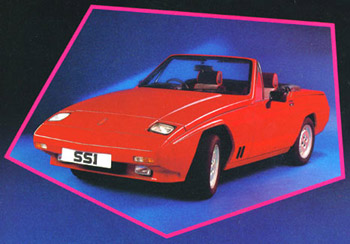
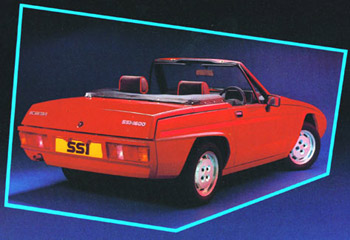

The Scimitar SS1 as launched at the 1984 Motor Show:
the first low-priced British convertible sports car for some years.The underbonnet
view shows clearly the position of the spare wheel and the Torx bolts holding
the front wings to the frame.
The market response
After a few 'scoop' photos of a disguised prototype in the press, the new sports car was officially announced at the 1984 Motor Show in Birmingham as the Reliant Scimitar SS1. In adopting the 'Scimitar' name for the new car, to be sold alongside the larger GTE and GTC, Reliant was taking a step to establish 'Scimitar' as a brand in its own right — emphasised by minimal use of the 'Reliant' name in marketing collateral and on the car itself. The retention of the development codename, SS1, on the production vehicle raised a few eyebrows given the connotations of the initials (and Jaguar's precedent in abandoning them forty years earlier).
Reactions to the new Scimitar were extremely good. Motor Sport hailed it as, "the natural heir to the Spridgets and Spitfires, MGBs and TR7s of a few years ago." The usually cynical Car announced that, "Reliant's new Scimitar SS1 roadster is no reincarnated MGB. Instead it's a lot better... [this] is a car that will make any MGB or Spitfire owner realise that masochism and mechanical mediocrity are no longer essential ingredients in ragtop driving."
There was praise for the handling and road behaviour, including the high-geared, sharp steering (derived from a Chevette rack) and the braking, which used Metro discs up front and drums at the back. The choice of fully independent suspension also proved wise: "It's fun to drive and you can throw it around with abandon" (Motor); "One quickly gets the feeling that the car can be made to do almost anything short of sit up and beg: and it's this nimbleness which makes driving the SS1 real fun... it takes very little skill to exploit the forgiving handling characteristics" (Autocar); "It's the sort of handling which supports, even flatters, the average driver and in which the better driver will revel" (Motor Sport).
(A dissenting voice was later to come from the late Russell Bulgin, who, writing in Cars & Car Conversions, criticised the planned neutrality of the SS1's handling as "exactly the handling characteristic you might expect from any run-of-the-mill European family hatch... the Reliant is a sports car for people who don't understand sports cars".)
While the 1300 model was, with 69 bhp, understandably, felt to be somewhat underpowered by many road-testers (Reliant claimed 100 mph maximum, and 12.7 seconds 0-60 time), the 1600, with 96 bhp courtesy of twin-venturi carburettors from the Fiesta XR2, gave a more respectable 110 mph and 9.6 seconds from 0-60. There was some criticism of the suitability of the Sierra gearboxes in terms of ratio spacing, but acceptance of the emphasis on fun rather than outright performance. Reliant let it be known that a higher-performance variant was certainly on the cards in the near future, which was sufficient to whet journalists' appetites; aftermarket turbocharged 1600 SS1s were also available from some specialists such as Robin Rew at Silverstone and Will Sparrow of Alcester.
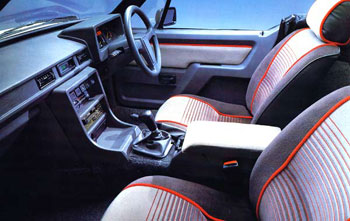
Jevon Thorpe’s SS1 interior. This is the 1600 model with a glovebox below
the armrest, and head restraints as standard. This early car has Ford instruments
but much of the switchgear is from Austin Rover; the seats were from the TR7.
Other aspects of the car again trod the line between everyday practicality and sports car compromise, largely successfully. The vinyl hood, with zip-down flexible back window as well as rear side windows, gave excellent visibility, and really could be raised or lowered in 30 seconds or so (a neat, body-coloured or black vinyl-covered GRP hardtop was available from autumn 1985). The SS1's boot was just about large enough for a couple of suitcases or a number of soft bags, with a substantial extra storage well hidden beneath a wooden 'false floor' insert (as Car put it, "you can bet the boys from Dover soon discover it to be a favourite place to store the odd bottle of Bordeaux"), and the space behind the seats was useful for extra luggage.
Mounted
on the 1600's transmission tunnel/backbone was a glovebox with a hinged lid
(the 1300 made do with a simple tray); behind this there was a space shaped
for a child seat to be fitted, even with the roof up, a design feature intended
to broaden the SS1's appeal to women — "the Chelsea executives'
wives, busy mums, aerobics classes, Habitat, Mothercare, Golf GTI set!",
as Performance Car said with some tongue-in-cheek. In fact, Reliant's
marketing data showed that around 75% of SS1s sold were second cars, so the
stereotype may have been correct. Regardless of the SS1's practicality, buyers
simply did not see a small sports car as a usable everyday car.
The SS1 benefited from a modern interior, designed by Jevon Thorpe, who had undertaken a placement with Reliant while studying industrial design at Lanchester Polytechnic (now Coventry University). Reliant sponsored the final year of his degree and on graduation, Ed Osmond recruited him to work on the SS1. Thorpe's interior was a significant advance over that of previous Reliant sports cars, with contemporary warm grey plastics and velour with red piping (leather seat facings were an option), combining a mixture of Ford and Austin Rover instruments and switchgear. A small, chunky-rimmed steering wheel incorporated a crash-pad in the tapering lozenge shape of the revised Scimitar logo which appeared on the car's bonnet. On early SS1s a Ford instrument panel was used, but this was later replaced by one from the higher-end Montego, complete with red 'grid' graphics. TR7 seats were used, with head restraints standard on the 1600 and optional on the 1300. Sound insulation was to a good standard, with thick foam-backed carpeting.
Even Russell Bulgin, again writing in CCC, was prepared to like it: "With its quality trim, unobtrusive design and good ergonomics, the understated elegance of the Reliant's neat interior almost makes up for the crass exterior detailing".
It was that exterior detailing which was to provoke the main criticisms of the car at launch, and indeed, perennially thereafter. William Towns — later to style the SS2, SST and Sabre — even approached Ed Osmond at the Motor Show and said, "Well, Ed, I see you've decided not to make it attractive then." Polite terms such as "unusual" and "distinctive" initially used by the media couldn't disguise the widespread disappointment at the SS1's aesthetics, especially the over-scalloped panels, wheelarch eyebrows and varying panel gaps, as discussed earlier. There was also dislike of the rather upright windscreen, the 'flatfish' appearance of the front end when the retractable headlamps were lowered (these were tilt-forward units, as on the Porsche 928, rather than pop-ups) and indeed even the 'unhappy' expression resulting from the use of rectangular lights and the pointed nose-cone.
Performance Car's Art Markus summed it up: "What lets it down, for us anyway, is the fussy and somehow disjointed detailing... We find the overall effect too much, like a simple, pretty country girl in tart's makeup. Somewhere in there is a pretty little car trying to get out."
Nevertheless, Reliant priced the SS1 competitively — under £8,000 for the 1600 and just over £7,000 for the 1300 — and orders began to come in for what was advertised as "The Getaway Car" by the company's newly appointed agency, Symington & Partners. Early production problems meant that only 36 of the 50 planned pre-production cars were ready by the beginning of 1985, but build was ramped up ahead of the official on-sale date of April 1985, with Reliant having gradually expanded its workforce (from 457 in 1982 to 541 in 1985) — the greatest ever production rate being about 40 SS1s a week during the summer boom months. The SS1 was initially assembled on the same production line as the Rialto and Fox, on the south side of the A5 at Two Gates, with very limited production of the last batches of GTE and GTC taking place on the north side.
Selling the new car required an expansion of the existing 38-strong Scimitar GTE/GTC dealer network (Reliant had separate networks for the economy cars and sports cars, though there were some dealers which handled both), and finding adequate representation was in itself a significant challenge for Reliant. There were 80 dealers by the end of 1985, often also holding TVR or Lotus franchises, but turnover among some of the new appointees was fairly high, with John Nash commenting that the, "performance of a handful has been disappointing and where necessary we shall have to seek alternative representation during 1986."
In the event, only 600 SS1s were sold in the UK in 1985 — a function of demand, sales channel issues and production difficulties. There were dimensional consistency problems with the Thyssen chassis which meant that some cars were 'out of square' (with the attendant panel fit difficulties) and supply hold-ups with bought-in parts meant that Reliant had to hold larger stocks than otherwise required — sometimes up to a year's worth — to provide a buffer against 'stock-outs'.
The comments of three long-standing Reliant workers speaking (about the Sabre, but the issues were the same) some eleven years later to Top Gear magazine's Anthony Ffrench-Constant, give some insight: "When we build [a car], nothing fits. We have to re-do everything by hand. You can't just pick up a cowl and fit it. You can't just pick up a dash and fit it."
The same Deloitte Haskins Sells memorandum mentioned earlier — in addition to the astounding "2½ bonnets per car" comment — also notes that in-factory rectification alone was costing Reliant an average of £1000 per working day, and SS1 production was responsible for much of this. When warranty costs were added, Reliant was losing around £500,000 a year simply on quality control problems, which for such low volume production, was dreadful.
Indeed, following the launch of the SS1, Reliant only returned to profit in the second half of 1987. The company was kept afloat largely by successful one-off deals such as building the RS200 for Ford (moulding the bodies, in composites including carbon-fibre and Kevlar, at Kettlebrook, and assembling the cars at Shenstone), selling the rights to the Scimitar GTE and GTC to Middlebridge, and selling off assets such as the spare parts business (to Unipart) and the Shenstone and, ultimately, Two Gates south factory sites. Against this background, the SS1 — sales of which tailed off to around 250 in 1986 — became increasingly irrelevant. Rumours abounded that a larger manufacturer — Lotus and Ford were both mentioned — would buy Reliant, primarily for its plastics expertise, and when Reliant won the contract to produce the bodies for the new Metrocab taxi, launched by Metro-Cammell Weymann in 1986, this focus on subcontracting became even clearer.
Ed Osmond had left Reliant in early 1985 to take up a similar role as engineering director at Carbodies, where his first task was bringing the revised FX4S taxi to production, and he was joined by Jevon Thorpe in 1986. The neat new FX4S dashboard which Thorpe designed for Carbodies was to be manufactured by Reliant Industrial Mouldings, in sheet-moulding compound; he went on to become managing director of London Taxis International, developing the TXI/II to critical acclaim, and is currently CEO of Modec, the electric van manufacturer.
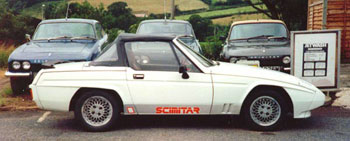
Distinguishing external features on the 1800Ti were
a discreet black boot-lid spoiler and a new wheel design, although owners
of the smaller-engined models have often also retro-fitted these.
More power
Reliant certainly did not give up on its sports car. The plans for a more powerful variant and the ambition to expand into the US market were dovetailed: the uprated vehicle would need to meet US emissions and safety standards as well as performance expectations. Primarily because of the emissions requirements, the carburettored CVH units were ruled out for US sales, and the fuel injected version (as used on the XR3i) was too tall to fit under the SS1's bonnet.
Looking beyond Ford, then, Reliant found the 1.8 litre fuel injected Nissan CA18ET unit, used in the Silvia, which, with a Garrett T2 turbocharger, gave 135 bhp and which already had a US/Canada approved variant (with a three-way catalytic converter and twin spark plugs, power was only down to 122 bhp). The compact unit fitted easily into the SS1's engine compartment and mated to a Nissan 5-speed gearbox, the whole package was well-suited. Autosport commented: "It's one of those engine/gearbox combinations that has you using the gears and the performance just for the hell of it.".
Launched in summer 1986, the Nissan-engined car was named simply Reliant Scimitar 1800Ti, with the SS1 name also being dropped on the 1300 and 1600. The main visual differences were a black boot spoiler, Alcantara seat facings and new diamond-pattern spoked alloy wheels, although most of the 1800Tis used in Reliant's publicity material were also fitted with a black roll-over bar, which was optional on all the variants, but particularly appropriate given the increased performance of the new car. US-market models would also have required side impact beams in the doors, and probably power steering and air-conditioning.
The performance was something of a revelation: the top speed was approaching 130 mph with, as tested by Autocar, 0-60 in 7.2 seconds (What Car? even managed 6.6 seconds). A 50-70 time in fourth gear, at 5 seconds, put the car into Porsche 944 and Sierra RS Cosworth territory. It was now able to compete with the 'hot hatchbacks' which had apparently filled the 'traditional' sports car vacuum for so many younger buyers; as Autosport put it, "With these sorts of figures, the Scimitar isn't going to be left behind on the drag strip when it comes up against the GTi brigade... "
Reflecting the cost of the Nissan components, the 1800Ti was significantly more expensive than the CVH-engined models — the retail price including taxes was, by autumn 1986, up to £10,300 for the 1800Ti (with the 1300 just £7495 all-in and the 1600 only £8625). Nevertheless, the new model immediately made a significant contribution in maintaining Scimitar sales, though overall these were still falling. From chassis number 900, the Thyssen chassis were galvanised (as the Rialto, Fox and larger Scimitar's had been since the early Eighties — together with the rust-proof body, potentially giving the car a very long life) and a left-hand drive variant was officially available, displayed at Geneva in March 1987. Around the same time, Ford's 1.4-litre CVH engine (75 bhp) replaced the 1.3, to produce the Scimitar 1400 with little real change in performance.
While there had previously been limited overseas sales to right-hand drive markets (New Zealand, Malta, Hong Kong and Bermuda), the introduction of the 1800Ti sparked interest from other markets, including Japan, where an order for 25 1800Tis was despatched in late 1986: given Japanese enthusiasm for classic British cars, a 'traditional' British sports car with a modern, serviceable Japanese engine had the potential to be an attractive combination (as the new Lotus Elan was shortly to show).
With the left-hand drive model available, European exports accounted for an increasing proportion of production — by mid-1988, production was roughly 55:45 split between export and home market models, with a £250,000 new paint facility at Kettlebrook improving the quality of finish. West Germany was the major left-hand drive market, with the Netherlands (where the Rialto also had a small market niche) also taking some cars. In Switzerland, where only a catalysed 1800Ti could be sold due to emissions regulations, six cars were ordered at Geneva; in France, Automobiles Clément, a Marseille-based importer, marketed the full range (1400, 1600 and 1800Ti) as the Mistral Scimitar, and indeed attempted to establish a network of dealers but this venture presumably did not sell many cars, given Reliant's low production volumes.
The 'big push' of entering the US market had yet to occur, but Reliant put increasing effort into planning this venture. Ritchie Spencer had told Ward's Auto News in 1984 that he "wouldn't mind teaming up with Jaguar dealers" to sell the Scimitar in the US, but while this idea was not to come to fruition, it was clear that a tie-up with an existing dealer chain was the best solution. It was, as marketing director Mike Bennett put it, "beyond Reliant's resources to market the car in the USA, [yet] the success of the Scimitar depends on the North American market."
Spencer resigned as Reliant's managing director in April 1987, and was succeeded by Cyril Burton, formerly Reliant's export director and an architect of Reliant's numerous overseas ventures since joining the company in 1969. One of his first actions was to register a subsidiary, The Scimitar Motor Company Ltd, "with the intention... to sell this separate company to a third party with the necessary finance to develop this excellent car for the North American market."
Last days of the SS1
In the event, the Scimitar Motor Company was never sold: a more complex pair of deals signed with Universal Motors of New York and the British American Motor Company (neither of which were ever fulfilled) were to determine the Scimitar's fate, with two different William Towns-designed models, the SS2 and SST, being spun off the SS1 chassis, both intended to remedy the 'appearance' issue while retaining the more successful features of the SS1. These deals, and the cars, along with the Sabre successor and the SS1's rôle in Rover Special Products' development of the MGF, will be examined in a future article.
The SST — all GRP, with no 'advanced' plastics — directly replaced the SS1 in February 1990, after around 1,500 had been built in total, at the same time that Donald Stokes — Lord Stokes of Leyland — became chairman of the new Reliant Group plc. Towards the end of SS1 production, informal internal figures seem to suggest that the tooling costs were being amortised at a cost of £600 per car — at this level, each Scimitar 1400 was losing over £300 while the 1800Ti was only making £40 profit.
Conclusion
Overall, then, what can we conclude about the Scimitar SS1? First, it's unfair to blame it in isolation for Reliant Group plc's collapse in October 1990 as has often been done by the media: that collapse was directly linked to Reliant's involvement in the property market from May 1989 onwards (with a reverse takeover by Wiseoak Group plc and Belmont Homes Ltd, two housebuilding companies) and the enormous debts thus accrued. The costs of buying the entire Metrocab business from MCW and setting up new production facilities, also in 1989, were substantial and returns would only have been seen in the longer term, which was not to be for Reliant.
Nevertheless, though profitable with no overdraft by the end of 1988, Reliant was in a weak position after the SS1 venture had absorbed so much capital for such little return. It is speculative but probably not inaccurate to say that had the SS1 been better received by the public (most simply, if it had been more attractive visually), the development costs would have been recovered earlier through greater sales in both the UK and Europe. It may also have led more quickly to a deal to distribute the car in the US.
Was the technological advancement embodied by SS1 — the method of body construction, and the complex chassis design — a hindrance rather than a help? The answer is, sadly, yes, in view of the manufacturing and assembly issues which led, again, to a much less appealing initial impression. A sports car, even if fun is a priority over performance, is still a status symbol for its purchaser, and, in much the same way as the TR7, the SS1 failed to project the right 'status symbol' image. However, the knowledge gained in working with more advanced plastics did raise Reliant's profile as experts in this field, resulting in major contracts which helped cash flow (and employment).
More generally, the SS1 showed that it was possible to update the traditional British sports car formula, retaining the ethos of the classic MGs and Triumphs but bringing other aspects into the modern era; it was not long before the Mazda MX-5 and the MGF did it successfully. It's a shame that Reliant was not able to play a bigger role.
As Andrew Nahum of Thoroughbred & Classic Cars put it in June 1985, soon after the car's launch, the SS1 was, "a brave venture from a company too small to afford mistakes."
©
Dan
Lockton, May 2006 | dan@danlockton.co.uk
This article is also featured on Keith Adams' excellent Unofficial Austin-Rover Web Resource.
Written
by Daniel Lockton with reference to:
The
Scimitar & Its Forebears by Don Pither, 1987/1990 (ISBN: 0951287303)
Reliant
Sports Cars by Don Pither, 2000 (ISBN 0750923881)
Rebel
Without Applause: Reliant from Inception to Zenith by Daniel Lockton,
2003 (ISBN: 1870519647)
Carbodies:
The Complete Story by Bill Munro, 1998 (ISBN: 1861261276)
Annual reports of J. F. Nash Securities Ltd, Reliant Motor plc and Reliant
Group plc, 1979-89
Internal documents provided by an ex-Reliant employee
Back issues of Car,
Autocar, Motor, Cars & Car Conversions, Performance Car, Fast Lane, Motor
Sport, Autosport, Ward's Auto News, Thoroughbred & Classic Cars, Top Gear,
Marketing and the Tamworth Herald.
For
more on the SS1: Dave Poole’s Sporting Reliants (www.sporting-reliants.com)
has an impressive collection of images; Eric Hofman’s www.scimitar.demon.nl
covers a variety of Reliant vehicles from an international perspective;
www.SS1turbo.co.uk
has information and documentation on all Reliant’s small sports cars;
and Phil Wormald has produced a comprehensive SS1 restoration site,
(homepage.ntlworld.com/phil.wormald/index.htm).
Clubs: Reliant Sabre & Scimitar Owners’ Club – www.scimitarweb.com; Scimitar Drivers’ Club www.scimitardriver.co.uk
Volume II: The Unquiet Survivor
Articles:
Double-edged sword: The Reliant Scimitar SS1
Paper: Motor Vehicles in the Developing World: Options for Sustainability [PDF, 320kB]
More articles coming soon
Coming soon : Links to other sites of interest and acknowledgements